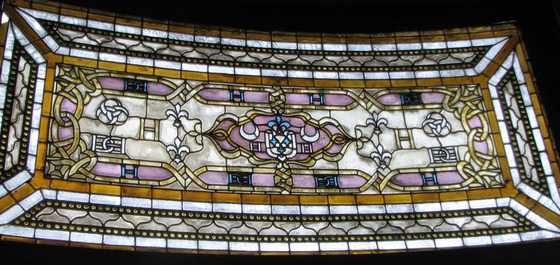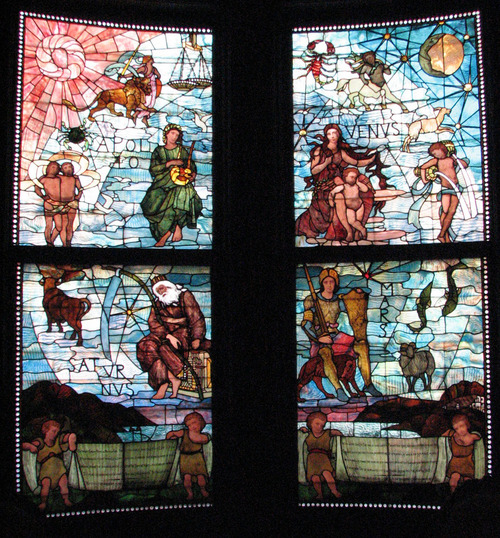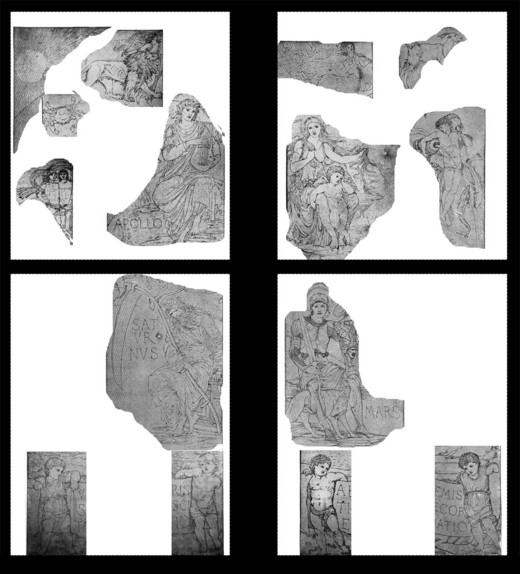May 24, 2009
Cupples House Stained Glass
I finally got a chance to visit the Samuel Cupples house, on the campus of St. Louis University, St. Louis, MO. "Finally", because their hours tend to be a bit unusual, so it's been difficult before now. As it was, I visited on a Sunday and they were only open because of a special event called "Rooms in Bloom". Whatever the reason it was, all in all, a very pleasant visit.
Richardsonian Romanesque design, Thomas Annan Architect, circa 1889
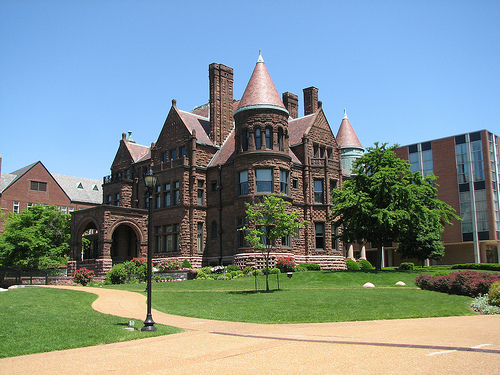
I posted 75 photos from the visit as a VitreosityPictures Flickrset of Samuel Cupples Stained Glass.
Decorative Drawing Room Window, circa 1889.
These were my favorites - very detailed decorative windows, with tiny pieces of glass and string lead throughout. This one looked to be around 18 inches high, with many of the individual glass pieces are no bigger than a fingernail. Great work. There are some 8-10 varied, detailed, decorative windows throughout the house.
Zodiac Window, 1889
This is the window I had heard of, and which used to be featured prominently on their website (but no longer - wassup?).
A placard at the museum stated that this is a Tiffany Studios window based on a design by Edward Burne-Jones. My initial response to the Tiffany attribution is skepticism, as the circumstances and the quality of the panel seem a bit wonky.
How exactly did a Burne-Jones design for a 'Four Seasons' design became a stained glass window for the 'Zodiac'? and by Tiffany Studios? and in St. Louis? I'd always assumed, before I saw it in person, that the Zodiac window was done by a good early St. Louis stained glass studio. The design, fabrication and painting seem a bit crude compared to the Tiffany and LaFarge windows I've seen over the years. I've only ever heard of one Tiffany Studio window being designed "based on" a non-Tiffany studio artist - a panel from 1894 based on a print by Toulouse Lautrec, and the style and circumstances of the commission simply don't match, IMO.
On the other hand, in terms of attribution, the decorative windows throughout the rest of the Cupples House are first rate technically, so it certainly does not rule out the Tiffany Studio.
more on the Zodiac window plus a surprise or 2 below the post...
Zodiac Window deconstructed
The design for the Zodiac window is based on a 'Four Seasons' design by Edward Burne-Jones, though it is not a straightforward translation, one to one. It turns out to be a pretty convoluted move from design to window.
These are images of the original 'Four Seasons' design from the book, Sir Edward Burne-Jones, A Record and Review, by Malcolm Bell. It's not even stated in the book what the design is for - a mosaic? a tapestry? a stained glass window?
from left to right - Spring, Summer, Autumn, Winter
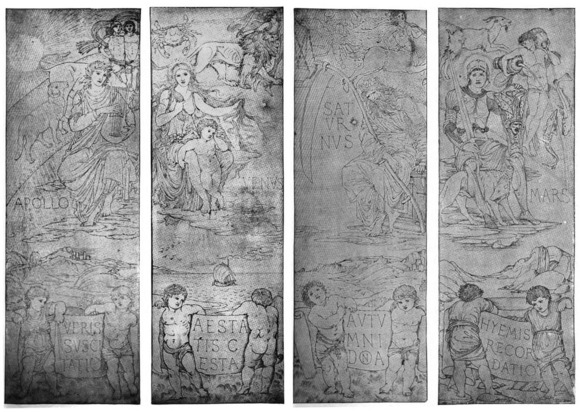
It's a bit of a convoluted translation. This is how the Burne-Jones figures and symbols are reconfigured into the Zodiac. On top of this, a number of symbols were added that were not in the original Burne-Jones design (Ram, fish, Moon with female figure). Additionally, the 4 "Four Seasons" scrolls with Latin text at the bottom are replaced by 2 scrolls with a poem by St. Louis based poet Eugene Field.
This shows what pieces went where and gives an idea of the patchwork nature of the translation -
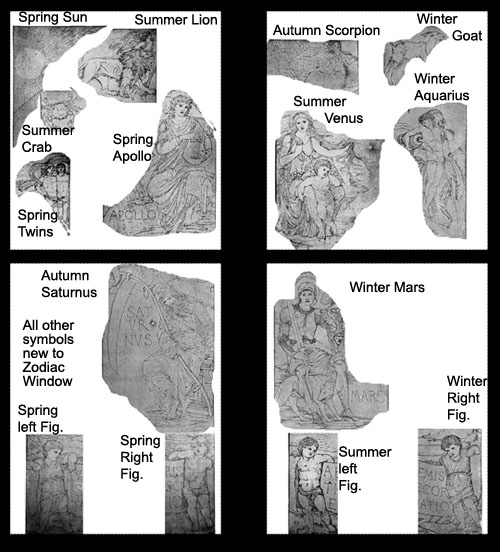
This process is not something I've seen in any other Tiffany Studios window.
Still, more evidence needed.
Whatever the attribution, there is much to like about this window. I especially like this bit of painting, where the white of the glass represents the beard and the paint represents the flesh. No matter the technique, it's a beautifully rendered expression of wearied age.
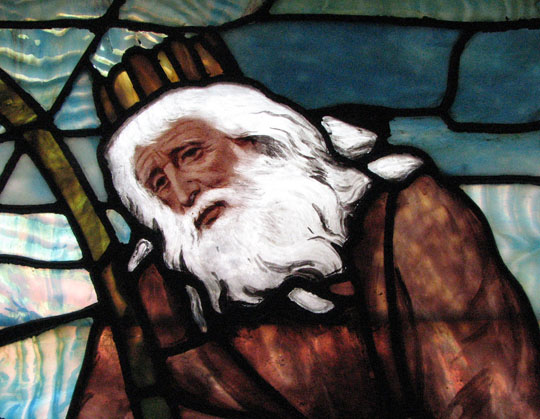
Mosaic Panels
These are a curious set of panels hanging in some windows on the third floor. There were no placards to elaborate. It's possible that they are a part of the glassware collection on the third floor and not original to the house. It's clear from the framing that they were once installed windows, but with no information as to where they were previously installed, or in what context.
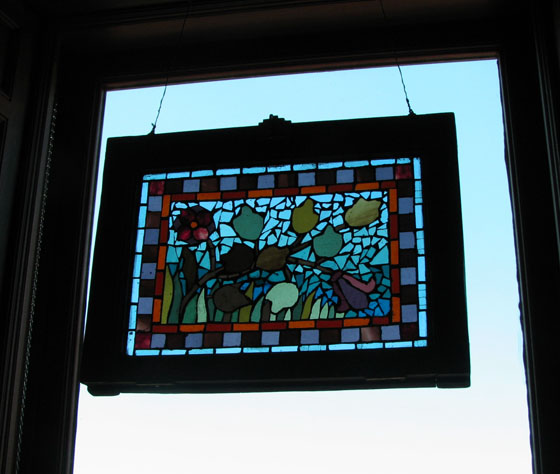
The fabrication technique is also unusual, in that it's done in a pure mosaic style, with pieces laid out and spaces filled in with molten metal or grout, with no lead came or copper foil used to create a channel for the glass to rest in.
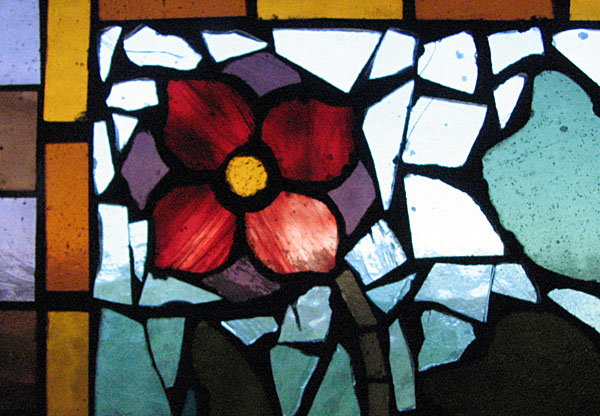
There is no backing plate and a number of the panels are buckling at least a half inch out of plane, so the matrix is likely metal and not any kind of ceramic-style grout. They seem to be done with a similar technique as the Belcher Mosaic process (1884 patent). Closer examination would be needed.
Again, check out the VitreosityPictures Flickrset of Samuel Cupples Stained Glass for more images.
March 12, 2009
Stained Glass at the City Museum
The most unique cultural institution in St. Louis is without doubt the City Museum. It is not so much a museum as it is a playground that happens to be a work of art, as well as a place for a collection of lots of stuff. It has, among other things, its own aquarium, its own circus troupe, a second hand clothing store, a glass blowing studio, a "museum of mystery, mirth and mayhem', tons of caves to climb through and a jungle gym set like no other, called 'MonstroCity'.
Photo of MonstroCity from flickrite 'mesjak'

Kids and artists love it. Parents do too, even with the slight air of danger. A friend of mine called it a 'parental anxiety machine'. I've never seen the same expression of wild unfettered creativity expressed in any public venue before. It is to St. Louis' credit that they simply let this thing happen.
There is also stained glass, in one form or another, peppered throughout. I've posted a City Museum stained glass flickrset on my flickr account - City Museum, St. Louis - Stained Glass Plus. I'll continue to add more as I take more pictures in the future.
In the meantime, I have a brief overview of what's at the City Museum, mostly in terms of the stained glass, below the fold...
[update Sept. 26, 2011 - Sad to hear of the death of Bob Cassilly, the founder and creative driving force behind the City Museum. Deepest condolences to his family, friends and co-workers. Let's hope the City Museum can continue to thrive for many years as a testiment to his vision.]
Mosaics
The first thing you see are the mosaics.
This video is a much better intro to the mosaics than anything I can come up with, and it also gives a good general intro to the atmosphere of the City Museum.
From "Living St. Louis", a local PBS TV series -
about the creator of the mosaics - "Sharon Von Senden - Mosaics" (7:19)
Architecture Hall
These images are located in the Architectural Artifacts section of the City Museum. This is one of my favorite sections of the museum though not so popular, probably because this is the one area that is more museum and less playground.
They have some 10-12 stained glass windows within this area, though most of the Hall is filled with decorative stonework.
Landscape Window
This landscape window is probably my favorite of the stained glass pieces.
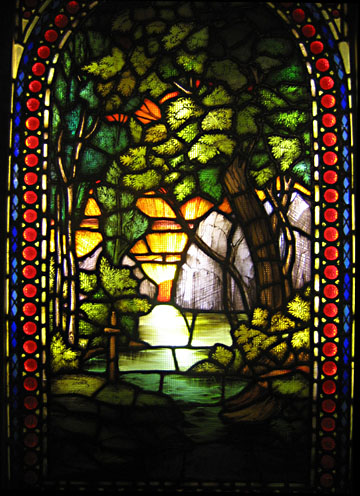
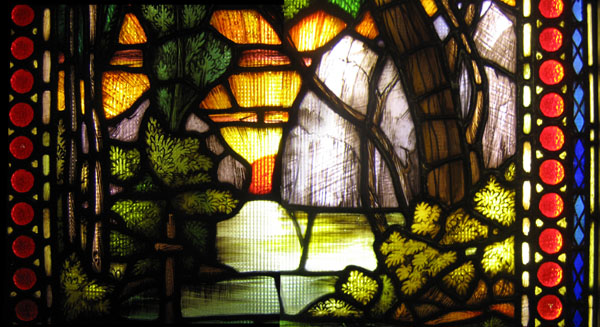
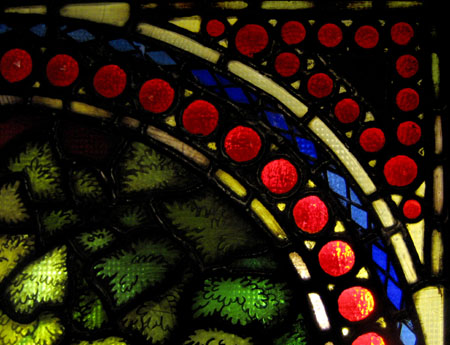
I suspect that this might be a mausoleum window, especially after I came across this image of this stained glass in Flushing Cemetary.
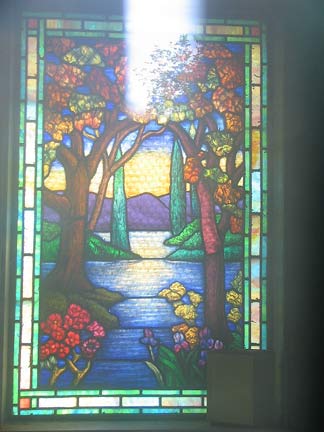
These next two images are from the Flickr set by Dimberly
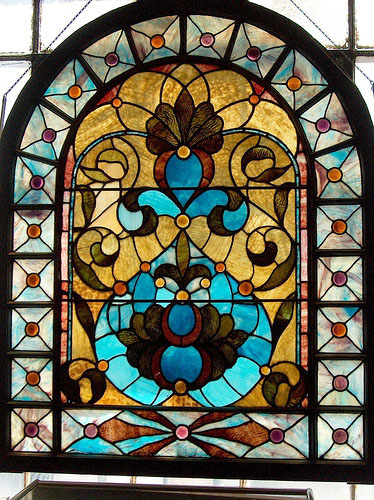
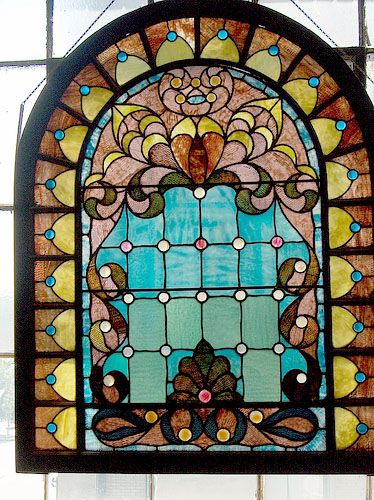
Aquarium Patchwork Window
There are about 4 or 5 stained glass windows in the aquarium. This patchwork window is the largest. I believe some of the glass in this was made at the on site glass blowing studio. Note that it is in a real aquarium. This window is right by the 'sting ray viewing platform'. There is an alligator only about 30 feet away.
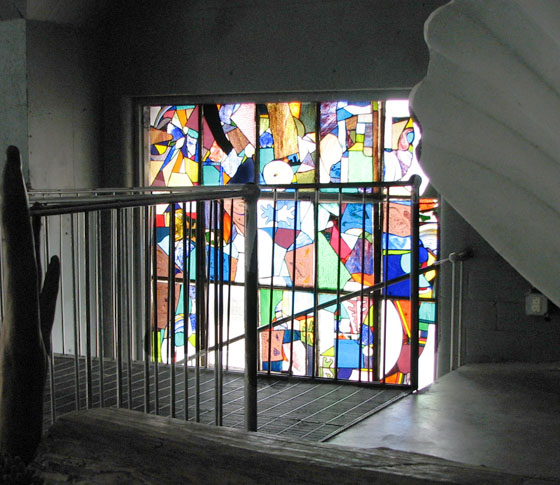
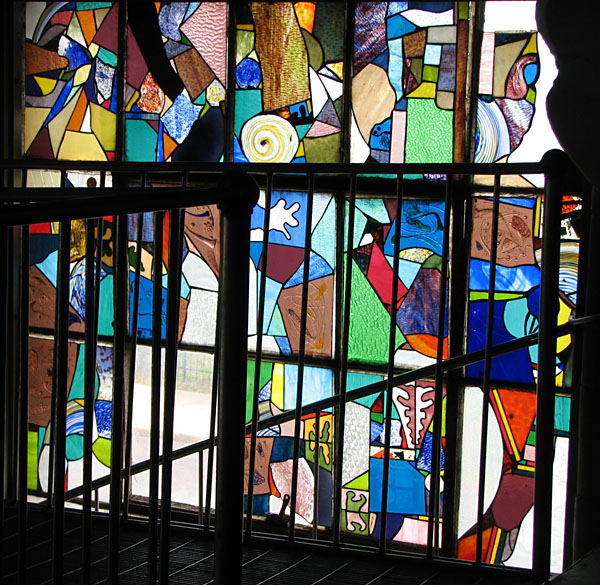
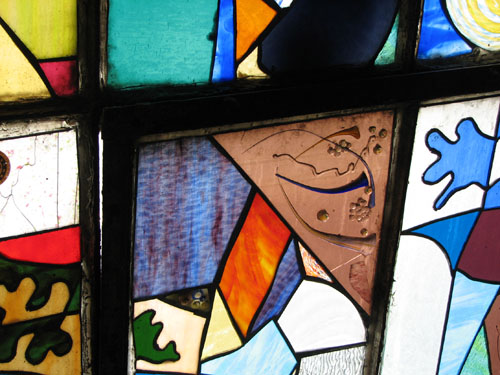
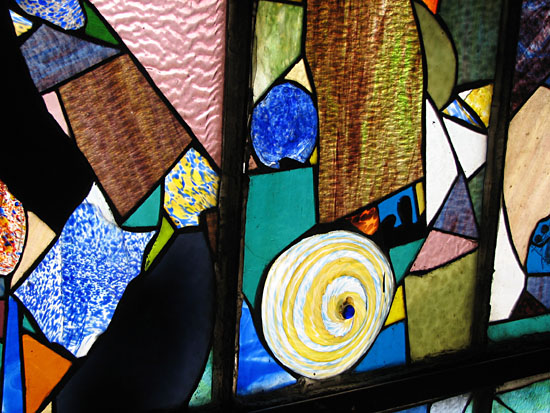
Bowl Wall
This is a wall sectioning an area where they have birthday parties and the like. It is in the same room as a vast playground, kind of an indoor skate park without skaters. I think it was considered too dangerous to let actual skaters loose on this. Kids go wild in here. Seriously.
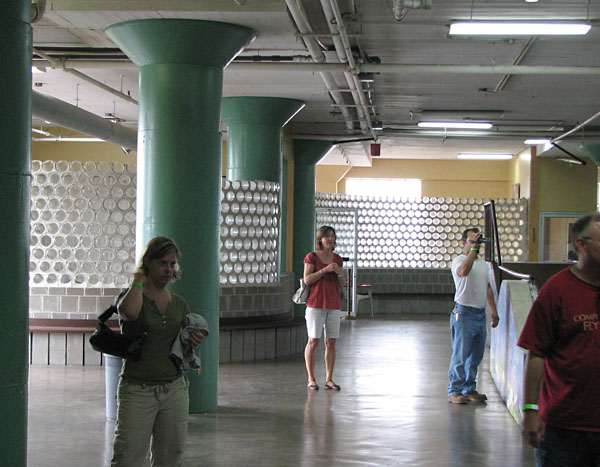
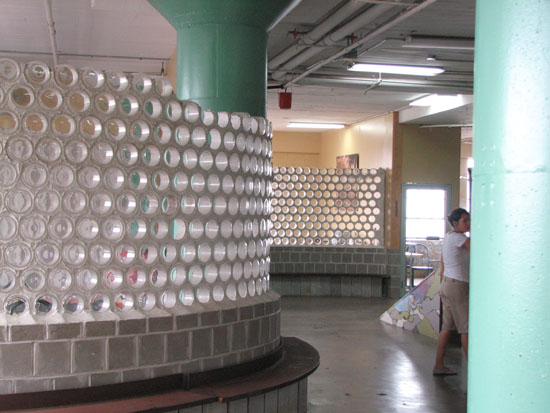
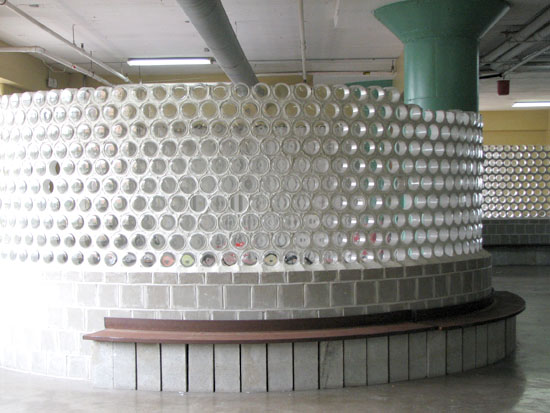
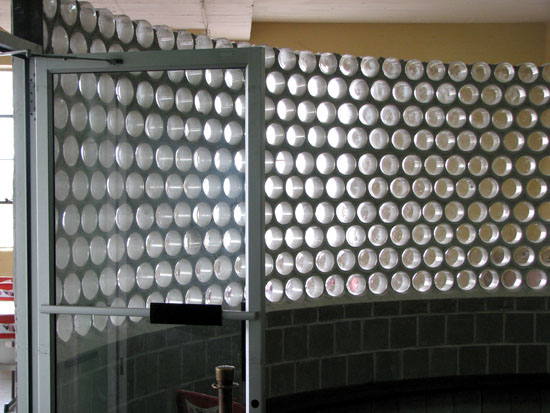
Clear Bottle Wall
This is one of two clear bottle walls in the museum, near one of the exits leading to MonstroCity. Thee bottle are glued together with clear silcone caulk.
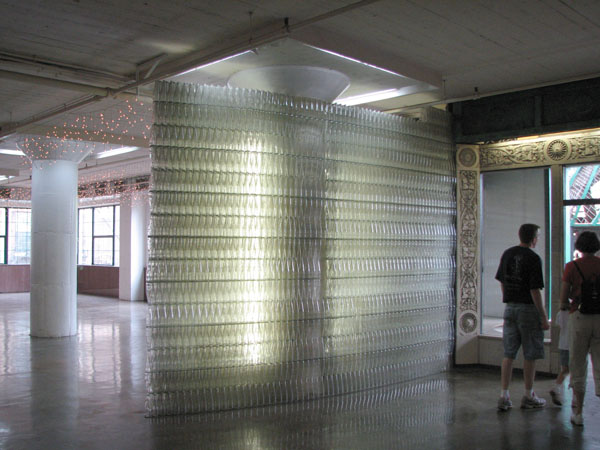
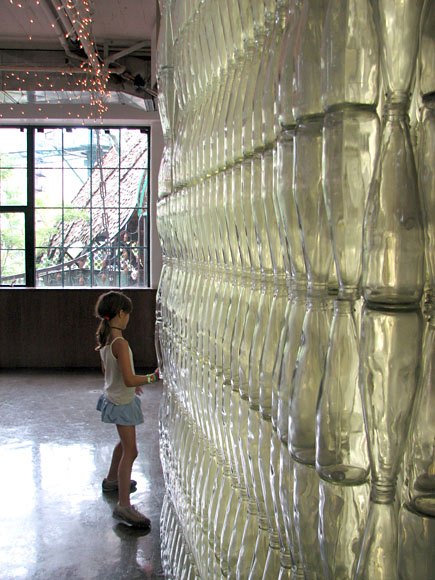
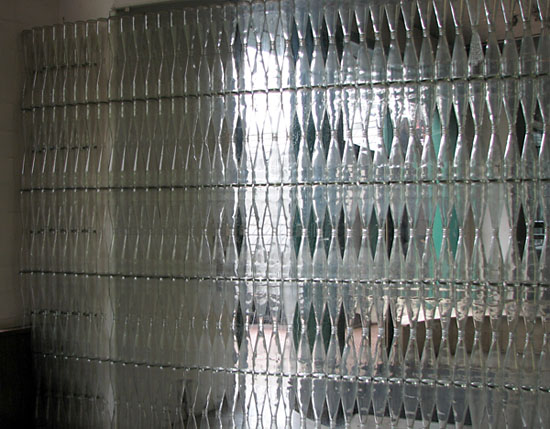
from rsun78 flickr page
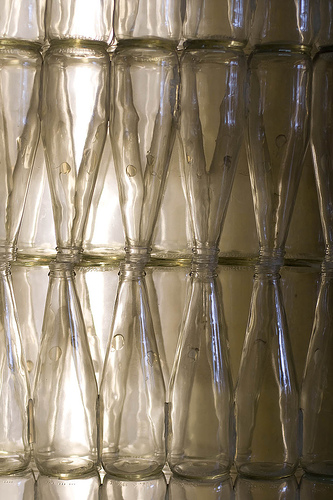
Big Clear Bottle Wall
This bottle wall is similar the the 'small bottle' bottle wall, only with large bottles. I've never seen large, clear, thin-neck bottles like this and I'm not sure what they would have been used for. It's located on the fourth floor, where there is a small knick knack shop and a large warehouse sized room with a shop selling vintage clothing.
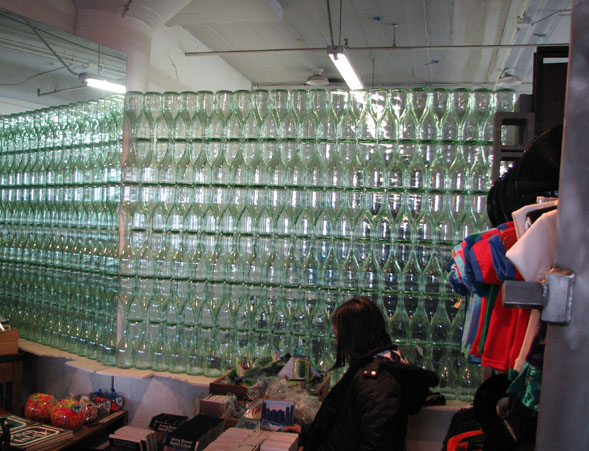
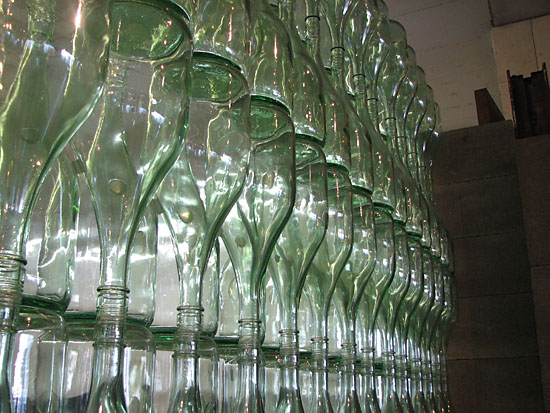
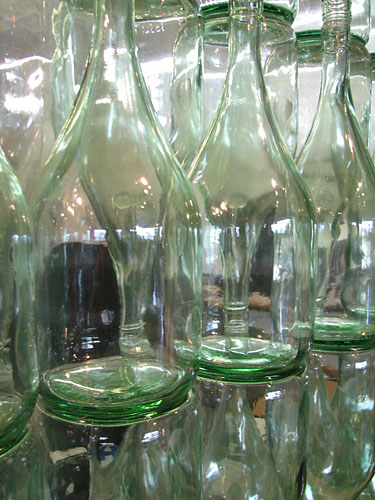
Oh, did I mention the room filled with old opera posters. That's a favorite of mine too, but it will have to wait for another time...
For more images, I suggest a Flickr search for City Museum, St. Louis. There are thousands and thousands of City Museum images.
There are also some interesting interactive panoramic images of the City Museum, through a thing called Gigapan. Not unlike Zoomify, but with extreme wide angle images.
December 11, 2008
Mapping Stained Glass Tours
I did a post last May about a website in the UK for a new Norwich Stained Glass Website. At the time I pointed out a unique feature which displays stained glass tours of Norwich called Trails. I checked it again recently, and it is improved and expanded. It's still incomplete and a bit confusing to navigate but what is up and working is very impressive.
The Norwich Trails idea works this way. You click on the 'trail' and it calls up a one page printable pdf with a map and images of several churches. For instance, The link for Trail 5 opens up a one page pdf of the four churches you could visit. Another area will go to webpages and bring up pdf's of the individual churches to get some idea of what they have for stained glass in that area, as well as logistical info. For instance, these are the links to the individual pdf pages for Trail 5 - St Peter in Ketteringham, St Mary Magdalen in Mulbarton, St Mary in Saxlingham Nethergate, and St Mary in Shelton.
This stoked my curiosity for something I'd been wanting to try for awhile. Google Maps lets you make custom maps. I wondered how it might work for mapping out stained glass tours.
I've been dabbling with it in my spare time for about 2 weeks and this is more a map of selected stained glass related sites in the St. Louis area, but worth a look. I may make some other maps that are more like a tour using the info from this map, with a suggested trail and timeline. I know from setting up tours myself, both formal and informal, that basic logistical information can be vital to the success of a tour.
St. Louis Stained Glass Sites on Google Maps
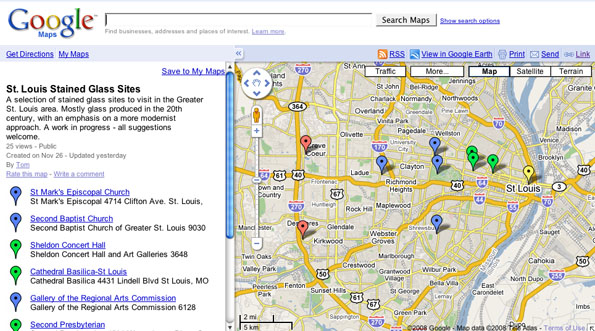
Consider this the 'beta' version. There will be changes.
All suggestions welcome.
August 19, 2007
Flickr Groups - Stained Glass and St. Louis
The pool of images available on Flickr grows larger and larger, with more than 90,000 images coming up if you search for 'stained glass'. Better these days to do a search in 'Groups' for 'stained glass'. More than 200 groups come up, showcasing specific categories such as English Pre-Victorian stained glass, Stained Glass in Brazil, and my favorite, a larger group featuring Stained Glass Details.
Details like this from Cringleford , Norfolk, England, UK
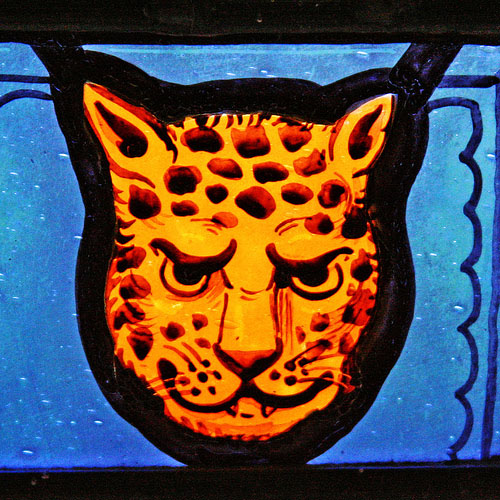
posted by the ever resourceful Leo Reynolds
In my desire to go deeper and deeper into searching out obscure photos of stained glass, I even ended up doing a search for 'stained glass' within the group 'Stl Architecture'. Speaking as one who has covered a good amount of stained glass in St. Louis, I found this especially interesting. There are nice photos of windows in places I've covered already - places like St. Mark's Episcopal and The Cathedral Basilica and the Really Big Jesus at Holy Redeemer in Webster Groves.
...and there are also a few maddeningly anonymous curiosities like this window, presumably in St. Louis, but with no specific location given and no other info.
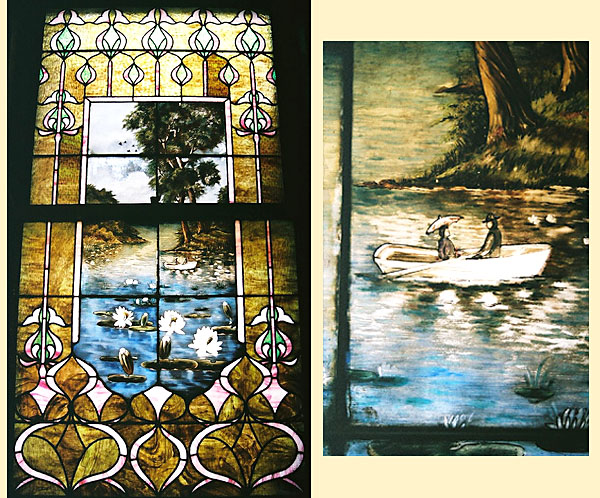
photos from the arbitrarymarks photoset
March 24, 2006
Second Presbyterian Church, St. Louis
Finally had a chance to stop in and look at the windows at Second Presbyterian Church in St. Louis. Nice group of Tiffany windows - including this rather somber figure of 'Faith' -
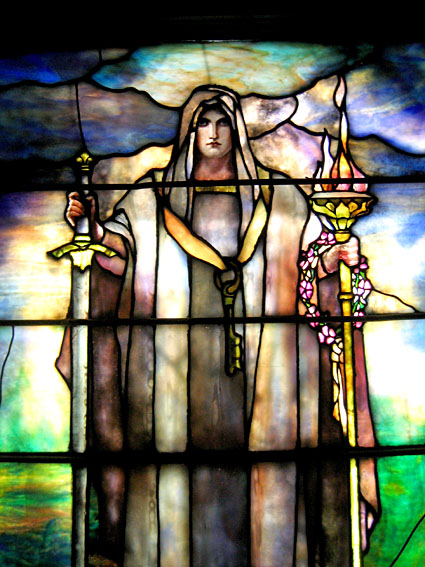
These Tiffany windows are more indicative of later Tiffany, with large areas of plated glass and small detailed areas using highly colored chunks of glass, such as the little wreath of flowers draped on the left hand. This church is going to be a part of the G.A.S. pre-Conference stained glass tour on June 14th.
November 27, 2005
Russell Kraus documentary on the web
There is a 30 minute documentary on Russell Kraus called, appropriately enough, "Artist Russell Kraus" from the local St. Louis Public TV station, KETC, for viewing over the web. Look for the specific video for Kraus under 'K' and the name "Artist Russell Kraus".
Some of the other segments deal with glass artists. Look for the piece on the hot glass shop called the Third Degree Glass Factory (the studio around which the 2006 St Louis G.A.S. conference is centered), and one on City Museum Mosaic Artist Sharon VonSenden.
November 05, 2005
2006 G.A.S. Pre-conference brochure
The pre conference brochure for the 2006 Glass Art Society Conference in St. Louis is out and available.
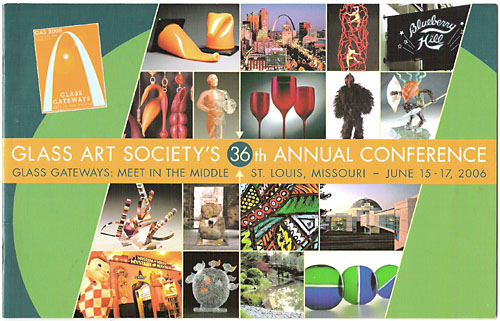
If you are a member of the Glass Art Society, you will receive one soon in the mail. If not, you can contact them and they will send you one. I will be doing a demo at the conference on Saturday, June 17th. The brochure also has some info on the stained glass tour that I am helping to organize - that is a preconference event on Wednesday June 14th. More on that later...
By the way, one of the images on the cover is from a panel of mine.
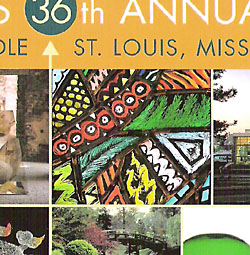
See the full panel - it's called Sketchbook Abstract #1.
August 28, 2005
Union Station
Finally got to Union Station in St. Louis to see the opalescent era window there. I'd heard it was a good one to seek out.
The initial view about the main doorway to the Hyatt.
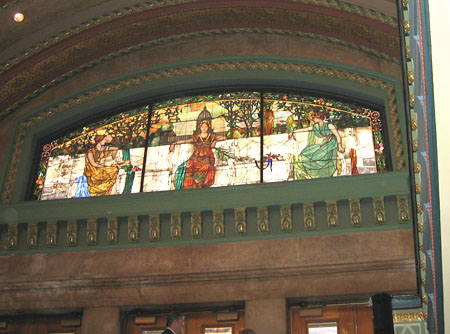
A straight-on view from the 2nd floor.
The figure on the left represents San Francisco, the figure on the right represents New York, and the figure in the center represents St. Louis.
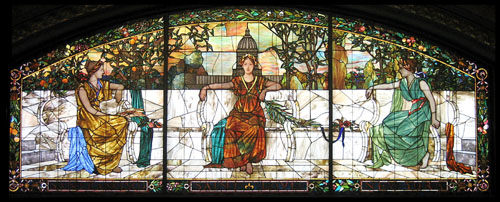
a closer view
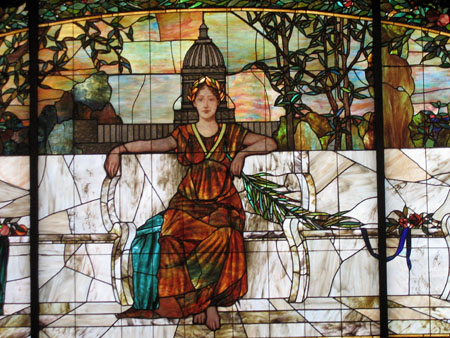
This window is apparently seen in the movie "Escape from New York". Part of the movie was filmed in Union station before its renovation.
August 16, 2005
SG Bandit follow up
Follow up on Stained glass bandit story from last spring - here and here.
August 03, 2005
Russell Kraus exhibit at Des Lee
This past weekend I went with my daughter to see an exhibit at the Des Lee Gallery of the work of Russell Kraus, who is best known in St. Louis as the man who commissioned Frank Lloyd Wright to design and build a house in Kirkwood, Mo in the 1950's. The house is now part of the parks system and is open by appointment to the public. It turns out Kraus is quite an artist in his own right, working mostly in commercial art starting in the 1930's and eventually designing stained glass windows for the Jacoby and Frei studios in St. Louis after the 1960's. He is still around at 87 years old and was at the exhibit the day I went there.
The first section I visited was, of course, the stained glass sketches -
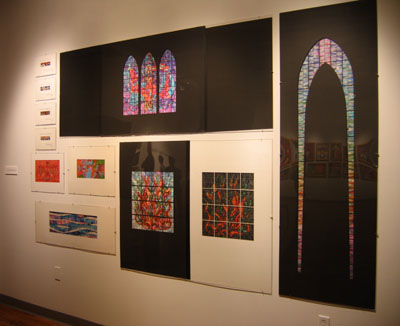
There was also a slide show with images from the stained glass and mosaic jobs he worked on over the years. This is one I thought interesting, though I believe it's just a sketch and not a finished window.
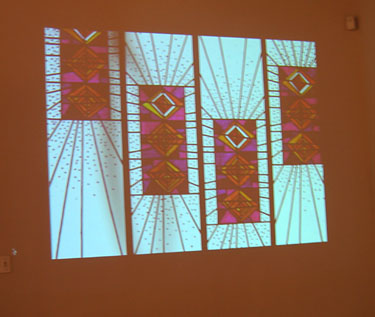
The other work was quite varied - early work in a kind of Robert Henri Ashcan-style, a little sculpture, WPA poster art, 1950's advertising art, small painted self portraits, even some jewelry -
one of the WPA era posters he designed -
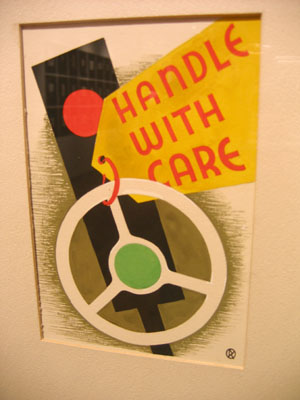
The pieces that received the most critical attention -
A series of paintings of children, fairly recent -
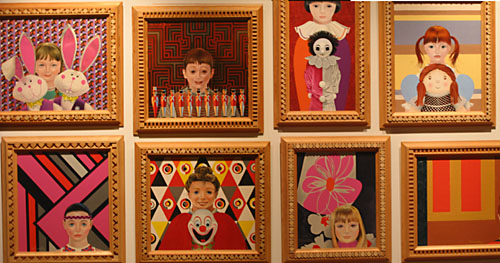
These, in many ways, seem the most unique works of the artist. All the others tend to fit easily in some other category. The stained glass work looks likes typical conservative modernist design work of the 60's-80's, the WPA poster art is typical WPA poster work, the commerical art looks like typical 50's advertising art. But these children paintings are unique to my eye.
Most, like the one below, feature a full frontal image of a child with matching object or motif.
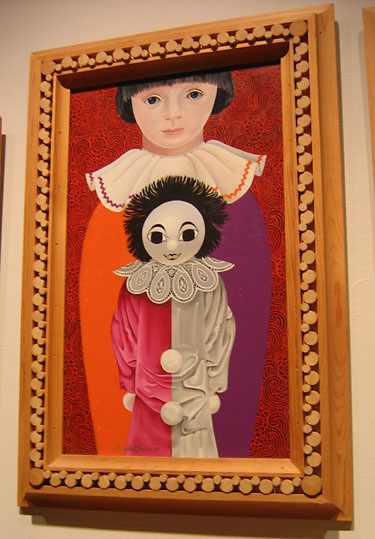
For the me the real richness of these works lies in the details - in this case,
the patternwork in the background. Even the frame construction is very precise and detailed.
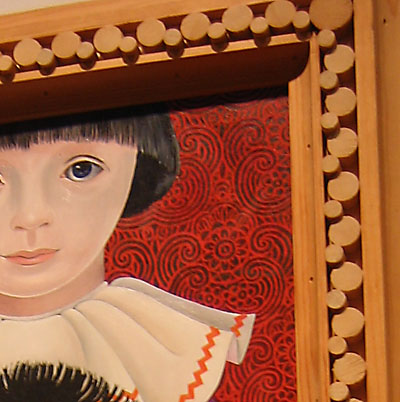
There may be an element of 'Dare to be Tacky' in these paintings that appeal to me as well. Most artists would not go near this subject matter for fear of being extremely maudlin, overly cute and sentimental. Others would embrace the subject matter and would indeed make it maudlin, overly cute and sentimental. It seems to me he plays with the idea of cute and does it in a way that is not being sentimental himself and not being a social critic either. It's a delicate balance.
[update - Nice 30 minute video about Russell Kraus on Living St. Louis, from KETC. Scroll down to 'K' and click on 'Artist Russell Kraus']
[update, Dec 2008 - started a Flickrset of the photos from this exhibit. I had so many more details, especially of the children painting pictures, that I felt the need to post more.]
[update November 24, 2009 - Russell Kraus passed away November 8, 2009 - Rest in Peace]
[update November 25, 2009 - I found a Flickr site showing Russell Kraus's Frank Lloyd Wright desinged Usonian House in Ebsworth Park. You can barely see the stained glass, but it is noteworthy that this stained glass was not designed by FL Wright, but by Russell Kraus, with Wright's permission. A unique situation in Wright's work.]
July 12, 2005
Gilula at Shaare Emeth
There is a new public glass art sculpture, Eternal Light, in the lobby of Temple Shaare Emeth at Ladue and Ballas. Made by Aaron Frankel and Ian Gilula of Elements Glass, out of Portland, OR. Gilula grew up in St. Louis and is described as a protege of Dale Chihuly.
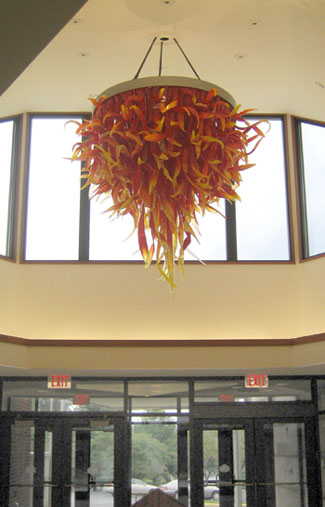
and a closer view
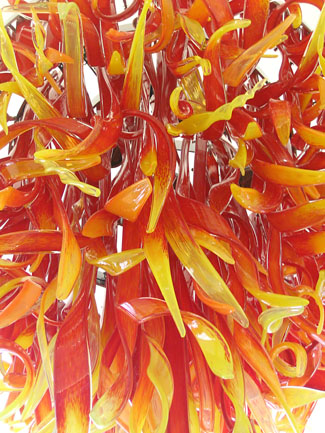
Shaare Emeth is also the home of Chihuly's first architectural commission for a public space.
July 11, 2005
First Congregational, Webster Groves
First Congregational Church of Webster Groves, MO
windows signed Frei studios 1994
des. Robert Frei
full shot of the small aisle windows
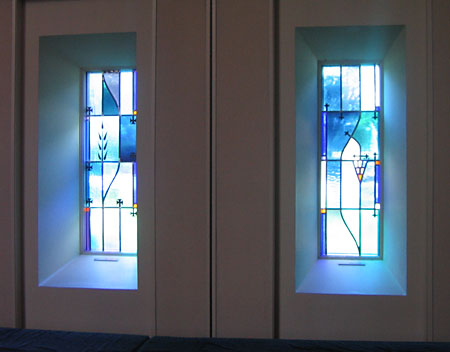
First detail - All these aisle windows are different.
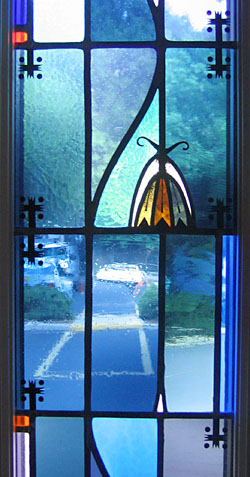
One thing to say for Frei -
they always use nice handblown antique glass, and a nice variety of it.
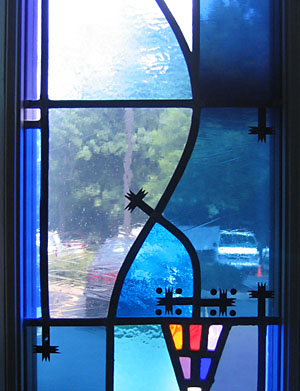
I like the way the little painted details are handled.
I'd call it playful, which is a quality not often seen in SG.
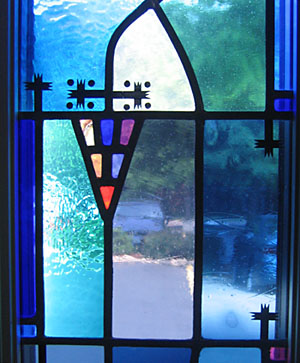
I like this rose window. I like the patterns and the varied and balanced colors. It is also, unfortunately, a classic case where the frame fights the design. The design of the window emphasizes the radiating 'out' and and the circular 'around', where as the thick tic-tac-toe frame just screams out HORIZONTAL + VERTICAL. Result: Frame and stained glass do not marry well.
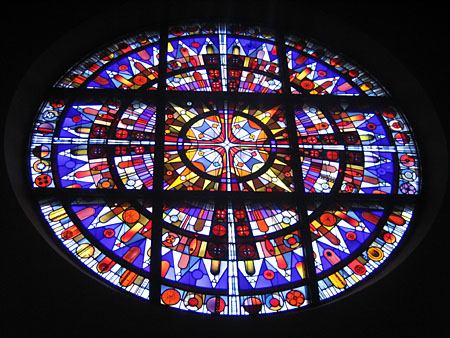
The nice stuff here is in the details. Note the little touches of secondary color coming in with the etched pieces. The red on blue flash in particular... and more hidden fishes...
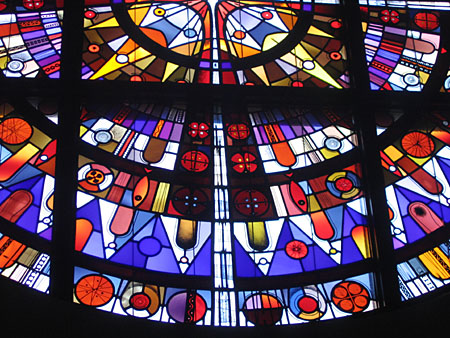
The exterior just shows the frame/design conflict even more.
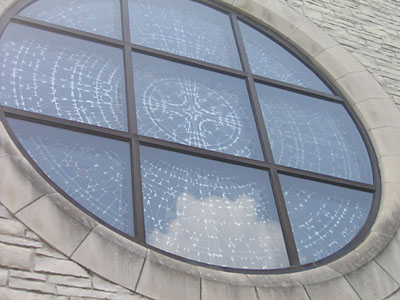
July 06, 2005
Holy Redeemer, Webster Grove
Visited Holy Redeemer Church, in Webster Grove, MO.
The first impression is that this is one big window, especially for a single figure - at least 18 feet across and 25-30 feeet high.
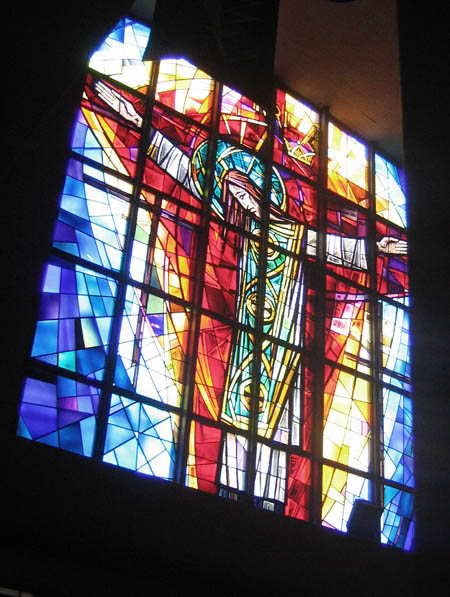
Here is a little more detail.
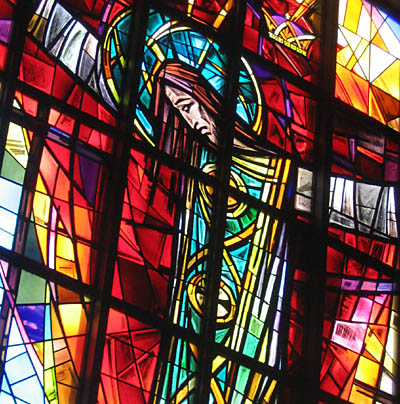
This is the exterior view - it gives a better sense of the scale
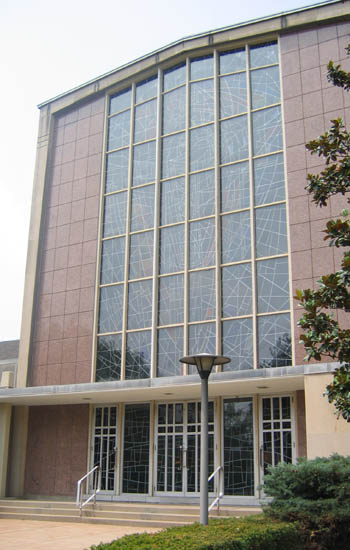
This is below the big jesus in the entryway - it's rare to see what are basically storefront frames filled with stained glass. but it works...
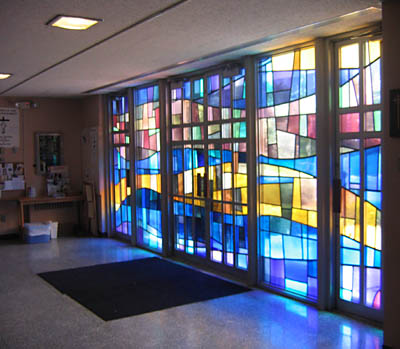
This is from a small chapel off of the entryway.
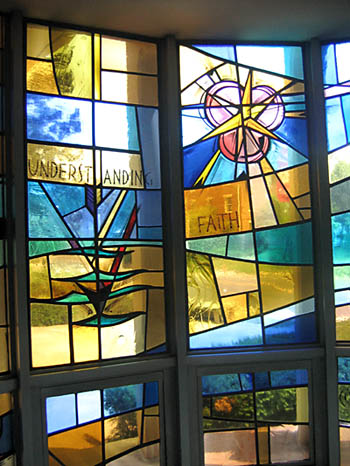
and a detail...
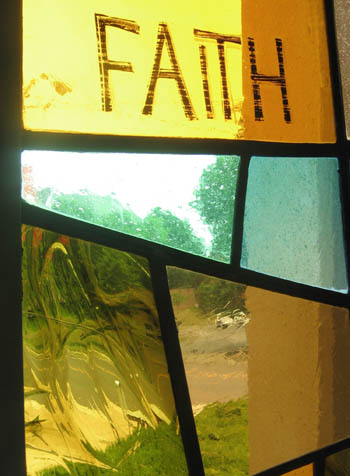
and another detail...
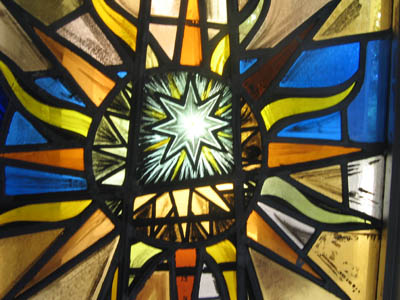
...and just one more look at that nice reamy glass in the chapel.
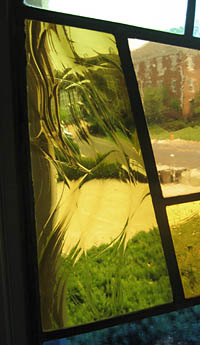
and finally, the exterior of the chapel - looking very 20th century modern.
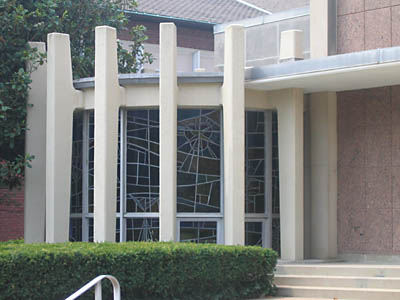
June 10, 2005
Derix in St. Louis
Recently saw this window at the St. Louis Regional Arts Commission's Cultural Resource Center. Here is the full exterior night shot.
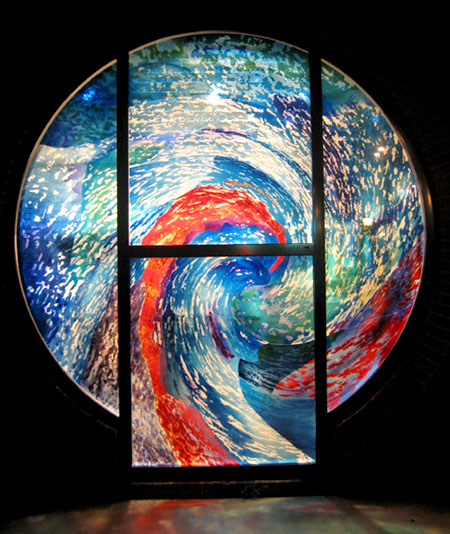
It's on the east side of the Regional Arts Commission building on Delmar in the U-City Loop in St. Louis. I must admit my first impression of this window was not positive. Granted that I had only seen it passing by in a vehicle, but I thought that it must be plastic or a cheesy non-permanent painting on glass. Basically, from a distance, this comes off as a very ordinary corporate style, status quo abstract design. (I'll try to get a daylight long shot to illustrate this...) Well, I happened to be walking past one night and got a close look at it from the outside. It's all glass and a pretty interesting piece for several reasons.
This is a closer view showing the text. The lines show the seperate pieces of glass.
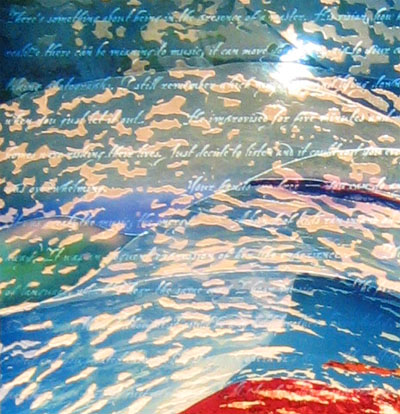
The piece is in at least three layers. The exterior layer is plate glass sandblasted with text that is not at all visible from a distance, and is barely legible up close. It's written in english, but with a hard to read cursive script. It may be more readable in daylight.
Very close at an angle to show the text most clearly.
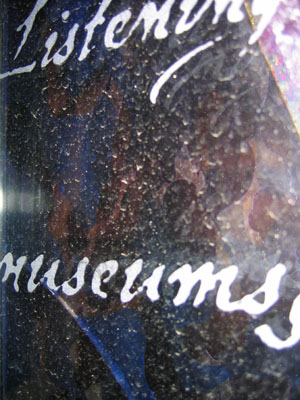
The color layers are flashed glass etched and cut and matched together in a kind of a tight puzzle. I assume it's put together with glue, though it could be fused together. The workmanship is very precise.
The details show some of the layering.
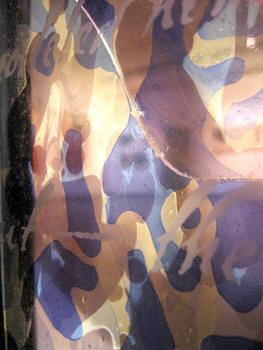
acid etched light blue and purple flashed glass - with what looks like some enamel painting, I believe.
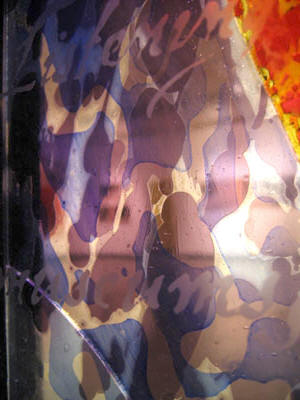
and a detail showing a more striking division of colors/glasses -
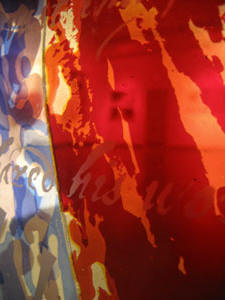
The artist is given as William M. Cochran, of Maryland. He apparently does mostly trompe l'oeil murals. The signature says it's made 'in cooperation with Derix Glasstudios'. Well, I certainly have heard of them and know they are in the forefront of developing experimental techniques on all kinds of architectural glass. Interesting that it's in St. Louis. I hear that a representative from Derix is speaking at the SGAA conference this coming month. It'll be curious to hear if this piece is mentioned.
May 31, 2005
Cupples House Stained Glass
There are new pages at the website for the Samuel Cupples House at St. Louis University, featuring some info on and photos of the stained glass windows. I still haven't gotten inside the Cupples House. Every time I've found myself at SLU, the place is closed... but it's on my list...
May 21, 2005
St. Louis Cathedral Basilica Windows
This from the Cathedral Basilica in St. Louis, most famous for its mosaics (41 million tesserae is the fugure used, I believe). The Basilica features some interesting decorative stained glass as well -- this is in a chapel on the left as you come in.
full window -
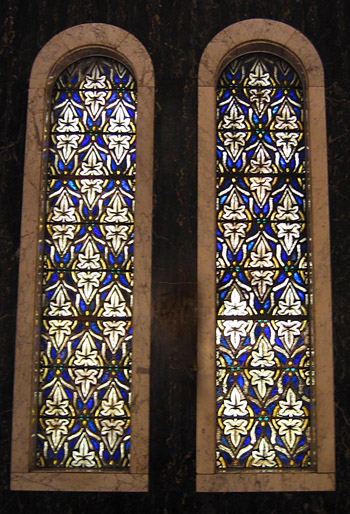
a closer look -
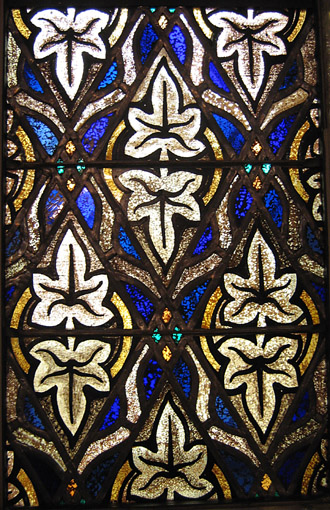
a closer look in reflected light -
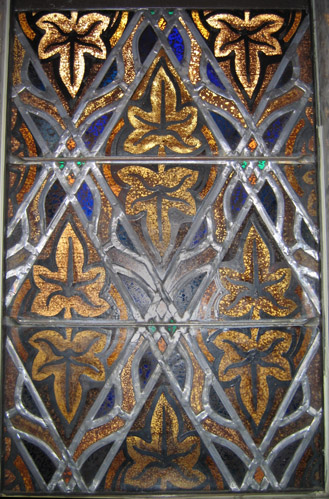
there are also these that have lots of interesting old jewels - something I've been looking into recently - I'm looking into making some custom jewels
the full window -

a close up -
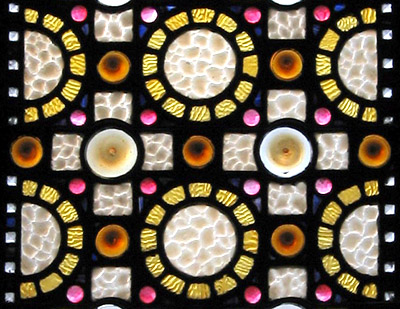
April 28, 2005
Stained Glass Bandit
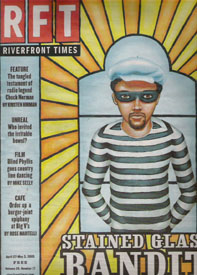
I've lived in St. Louis for about six months now and didn't hear a thing about this. Just too too bizarre.
Windows -- stained glass windows, to be precise -- commenced crowding the crime maps at Caruso's South Patrol Division this past summer. Joining wrought iron, terra cotta, fireplace mantels, even the black metal stars affixed to earthquake bolts, glass had seemingly become the latest architectural object St. Louis thieves had found they could pop and peddle.
April 09, 2005
St Marks Episcopal, St. Louis
About a month ago I visited St. Mark's Episcopal, the first church in St. Louis to be built in the modern style. Basically, Art Deco design. Very striking. The windows were designed by Robert Harmon and made at the Frei studios of St. Louis in 1939.
All the windows are tall and narrow with a stylized image of Christ at the top leading down to different symbols for that particular window. The colors throughout feature this nearly monochromatic shift from white to lavender to variations of middle blue. A very difficult range of colors to make work with - and here it works very well.
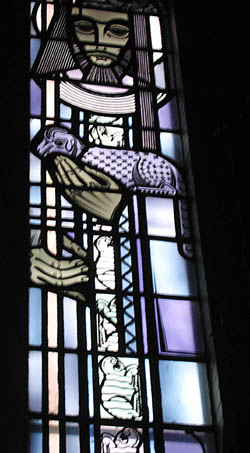
The image at the bottom of this window is something of an in joke - as the architects were named Dunn and Nagel, German for hammer and nail. The theme for the window is 'cooperatively working together'.
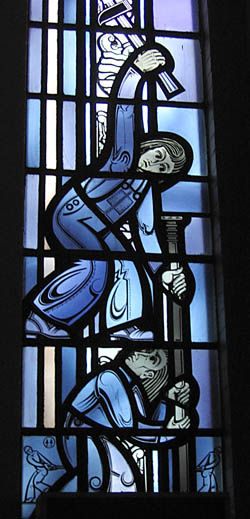
The leads are wide. The vertical lead in the upper center area of the photograph is about 1.5" wide. The majority are about 3/4" wide. Much wider than usual for stained glass. If you look closely you'll see this is the head and hand of the figure at the bottom of the Dunn and Nagel window holding the nail.
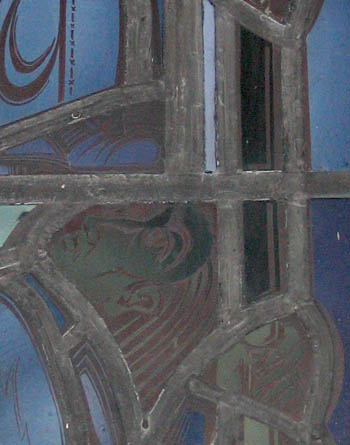
A deco lion, symbol of St. Mark.
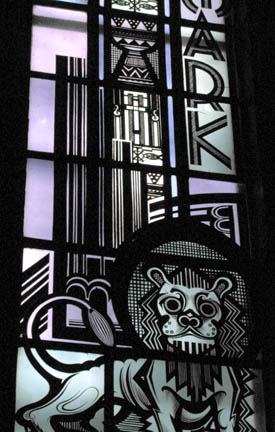
There is a strong element of social justice in these windows. The one below is sited most often with its references to labor exploitation and racial prejudice. Highly unusual in stained glass.
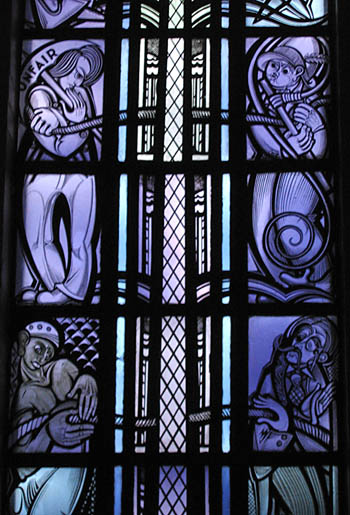
March 21, 2005
St Francis Xavier (College) Church
Quick look today inside St. Francis Xavier (College) Church, at St. Louis University.
All the windows are by the Emil Frei studio, out of St. Louis, done in the 1930s. The windows are a straightforward gothic revival (american version) style, with mostly standard figural scenes. The tone of them almost suggests grisaille, for there is a good amount of white. The main exception being the large piece behind the altar, which is in bright vivid primary colors, almost coming off as abstraction from a distance. That one was impossible for me to photograph.
The most interesting windows were tucked in out of sight in the transcepts. One is this tree window which has in interesting mix of painted grisaille (the vines and leaves) and standard mosaic style (tree trunk and grapes). This is in the South transept, facing the altar.
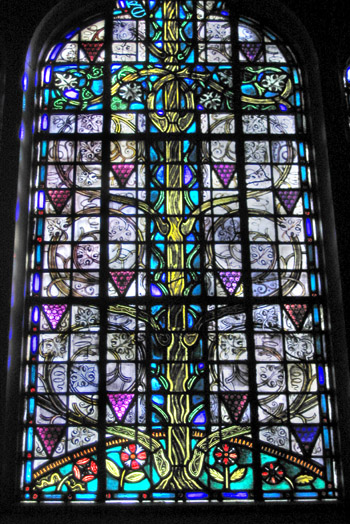
This detail shows the grisaille vines and leaves better.
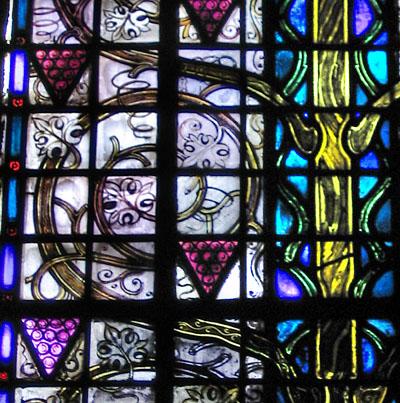
This is in the North transept, facing the altar.
Offhand, I like this one the best in the whole church.
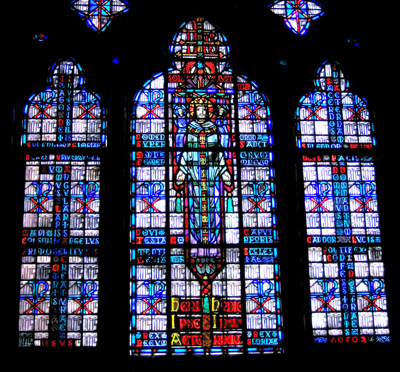
Looked at more closely this looks to be all text, albeit with a lot of repetition. I like this idea. Not sure what that main character set in the quarries says.
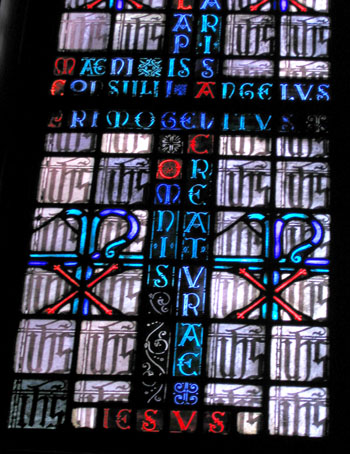
I can't help but think - what if this featured all readable text - wouldn't it increase the interest of the window as a whole? Is it simply a matter of making it in English rather than Latin? But I'm not sure I'm even catching what the Latin words are most of the time. Funny how this is an issue that this artist shares with graffiti artists. Artistic style or readable content?
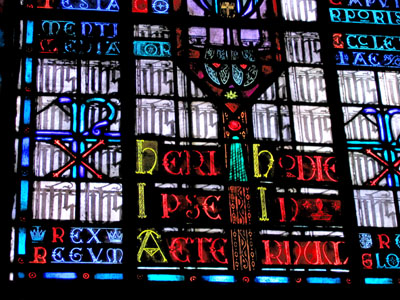
March 11, 2005
Christ Church Episcopal, Downtown St. Louis
Kind of choppy selection of windows here. There are some early Connick windows in a chapel (too far away to photograph), 2 small average-at-best Tiffany windows, and several (painted that are covered over by an attached building. The most interesting were two windows in a French Gothic style. Unsure about the studio.
The "Jesus enters Jerusalem" window in full -
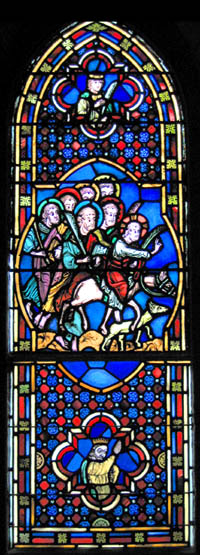
A detail of the lower section -
I have no idea who this figure is supposed to be.
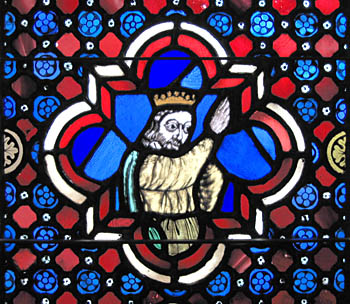
and a close up of the small figure -
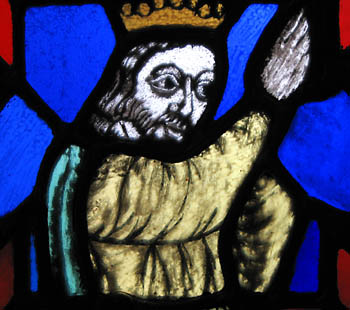
There are also a few windows in this style. Large pieces of glass, like the trim on the sash - all one long piece.
I like the face on this one, it could almost be a William Blake head.
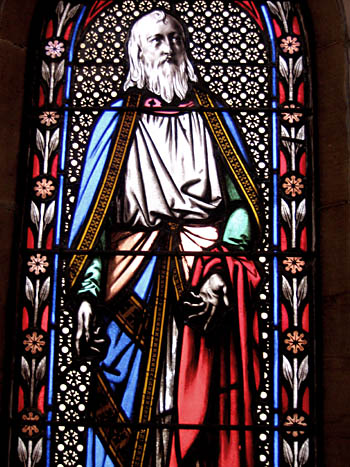
March 04, 2005
Chihuly at Shaare Emeth
The temple we attend in St. Louis has these stained glass windows in the main chapel area. Contemporary style - very minimalist. I had seen some similar ones in photographs particularly in the early 90's, but I could not recognize the artist. These turn out to be earlier (late70's/early80's) and by none other than Dale Chihuly. Not at all like his more recent wild-style, anemone-like constructions being made for practically every museum on the continental US.
There is mention of the Shaare Emeth Commission on Chihily's website, though buried in the back in old installations. It turns out this installation is Chihuly's first installation for a public space!
Here are some pictures taken recently. These windows are extemely difficult to photograph. The contrast in light is extreme. When photographing, the window details get blown out very easily.
The glass is superior quality handblown flashed glass, with a good amount of gold pink flash. Each piece is acid etched. The red/pink and grey columns are symbols for the columns of smoke and fire that led the Isrealites in the desert.
This is the left side looking toward the Bima (central altar in a synagogue).
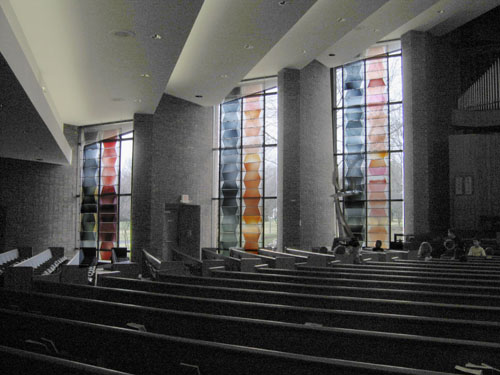
The right side looking toward the Bima.
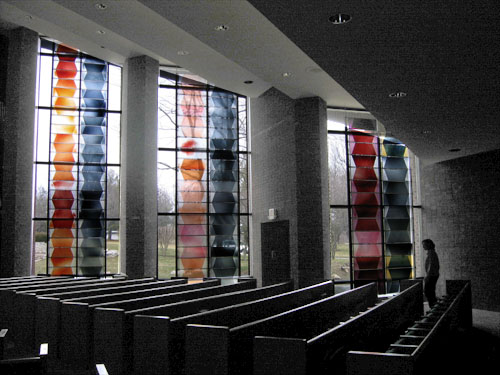
A closer shot of the panels on the farthest right.
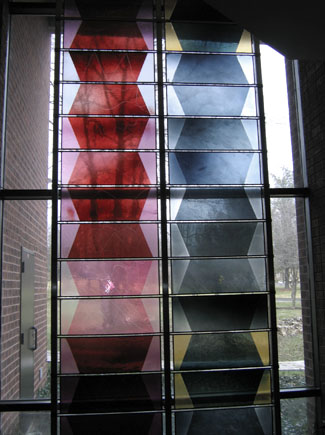
A even closer shot of the window on the farthest right,
where the pink is in between the red on rose pieces. These are at eye level.
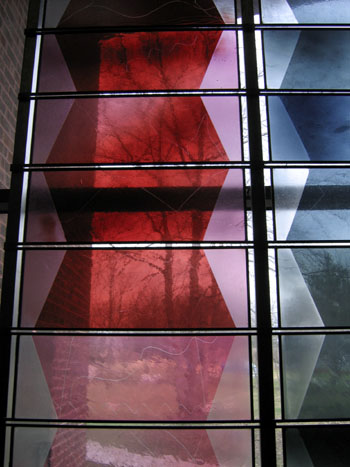
and a close up showing the lines etched away on that same panel.
Not all panels have this thin line etching.
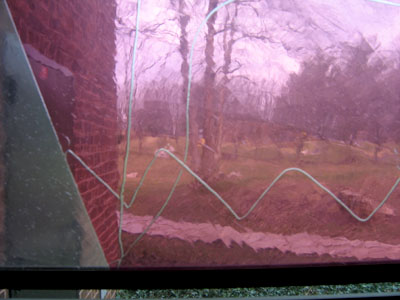
And this is a look at the metalwork. There are what appears to be brass channels holding each individual piece of glass.
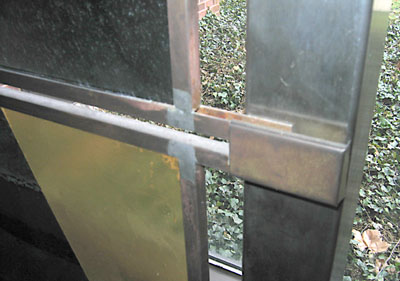
[update april 29, 2005 - I just saw these windows for the first time in morning light and they come off much better. The unique quality of the handblown glass shows up much much better with the indirect light of the morning.]
February 28, 2005
Kirkwood First Presbyterian Glass
I'm going to try to document some of the glass I see over the next few months in the St. Louis area, focusing on what makes an impression. Not necessarily what is the biggest or even the best, but what is of interest to me at the moment. The small corners and little details.
First up is Kirkwood First Presbyterian Church, right across from my local public library.
The large area of glass is above the altar.
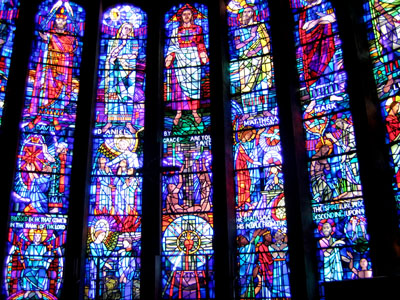
Bold black line painting, little or no tonal painting and bright primary colors.
The colors are a bit hot for my taste.
Still, I like the side aisle windows, small (about a sqaure foot each), each designating one christian symbol. There are a number of them along the wall on east wall. Of course, I always like the little panels best...
I especially like this rather languid looking ox with wings, a symbol for St. Luke - 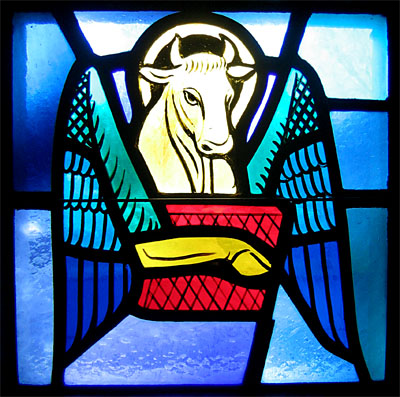
and a detail
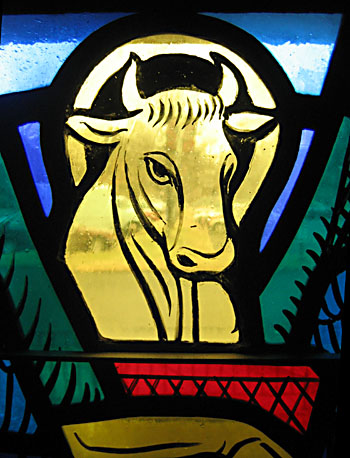
October 05, 2004
Missouri Stained Glass
Having moved this summer to St. Louis, Missouri, I figured I would do some homework on stained glass in the area. Luckily, I found, in a local St. Louis bookstore, the book "Gospels in Glass - Stained Glass in Missouri Churches". Then I recently found out there is a related website that has some images from that book, by the authors. It's good to read of the background history of stained glass and stained glass studios in St. Louis. Of course, I'd be interested to see the secular work as well. There seems to be a fair amount of it, especially in the older buildings.
July 20, 2004
Windows at Webster
Saw these unusual windows in Webster Hall at Webster University in St. Louis, Missouri. The windows consist of just the nine pieces of handblown seeded clear glass painted and stained. The stylization is very much in keeping with illustration of the 50's and 60's. Unfortunately, they are unsigned and I didn't have the time to ask for further info.
The full window -
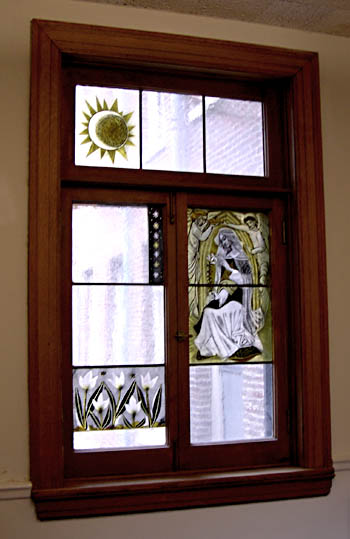
and a detail
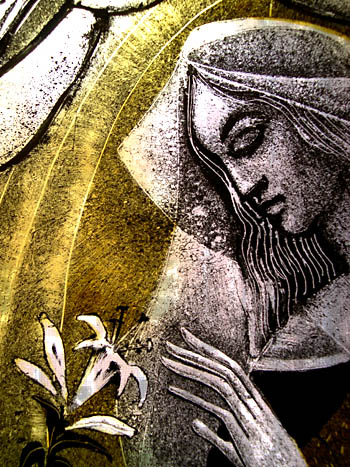
and another detail -
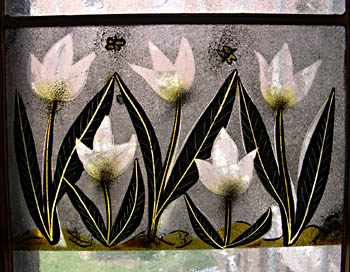
There are 3 others similar to this, but the photos came out best on this one.
June 17, 2004
Seen in St. Louis
Saw this recently in the dining room of the Mayfair Hotel in St. Louis. Nice windows throughout the room. A pleasant illustrative style. Made in the 1920's though the artist and maker are unknown. Any ideas?
[update December 1, 2009 - The studio that did the Mayfair windows was the Jacoby Art Glass Studio, in St. Louis. Jacoby's went out of business in the 1970's, but there is a nice webpage about the History of the Jacoby Art Glass Studio online. The information is a bit of a jumble, but according to this site, the Mayfair windows were designed by Lee Cook, though no date is mentioned. The hotel opened in 1925.
Also related to the Mayfair SG, I posted a Mayfair Hotel Dining Room Stained Glass Flickrset a few months ago. 25 photos, lots of details]
Here is a shot of the panels in one room - with the theme of 'Courtship'.
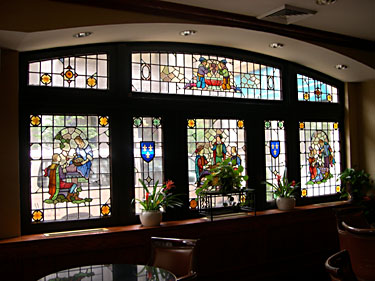
and here is a detail of the panel on the farthest right.
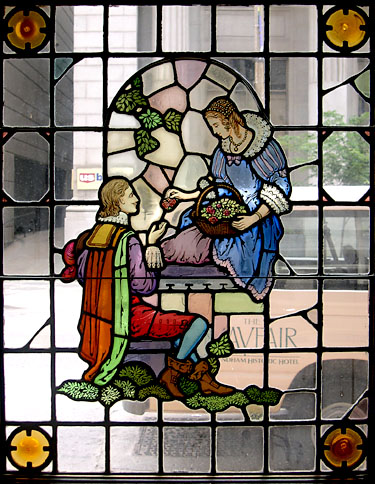
A nice sweet style.
----------
This panel is from the other room where the theme is apparently still courtship, though the emphasis is more on revelry. This panel is probably my favorite of the whole group. The figure is a bit bigger than the others and I like the quality of the linework and the brighter color.

